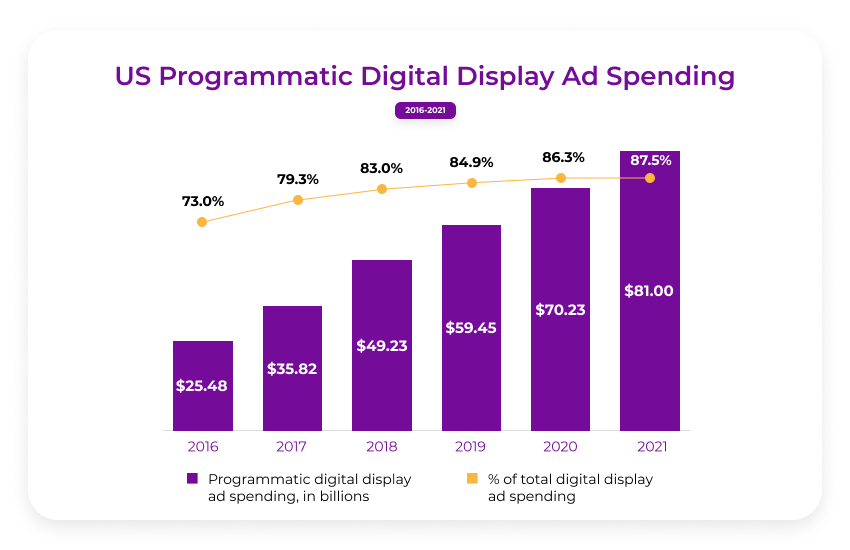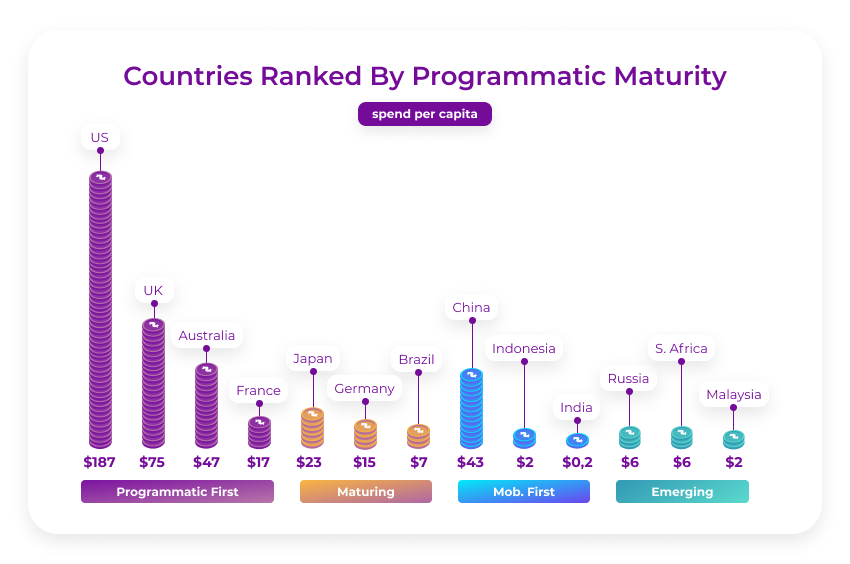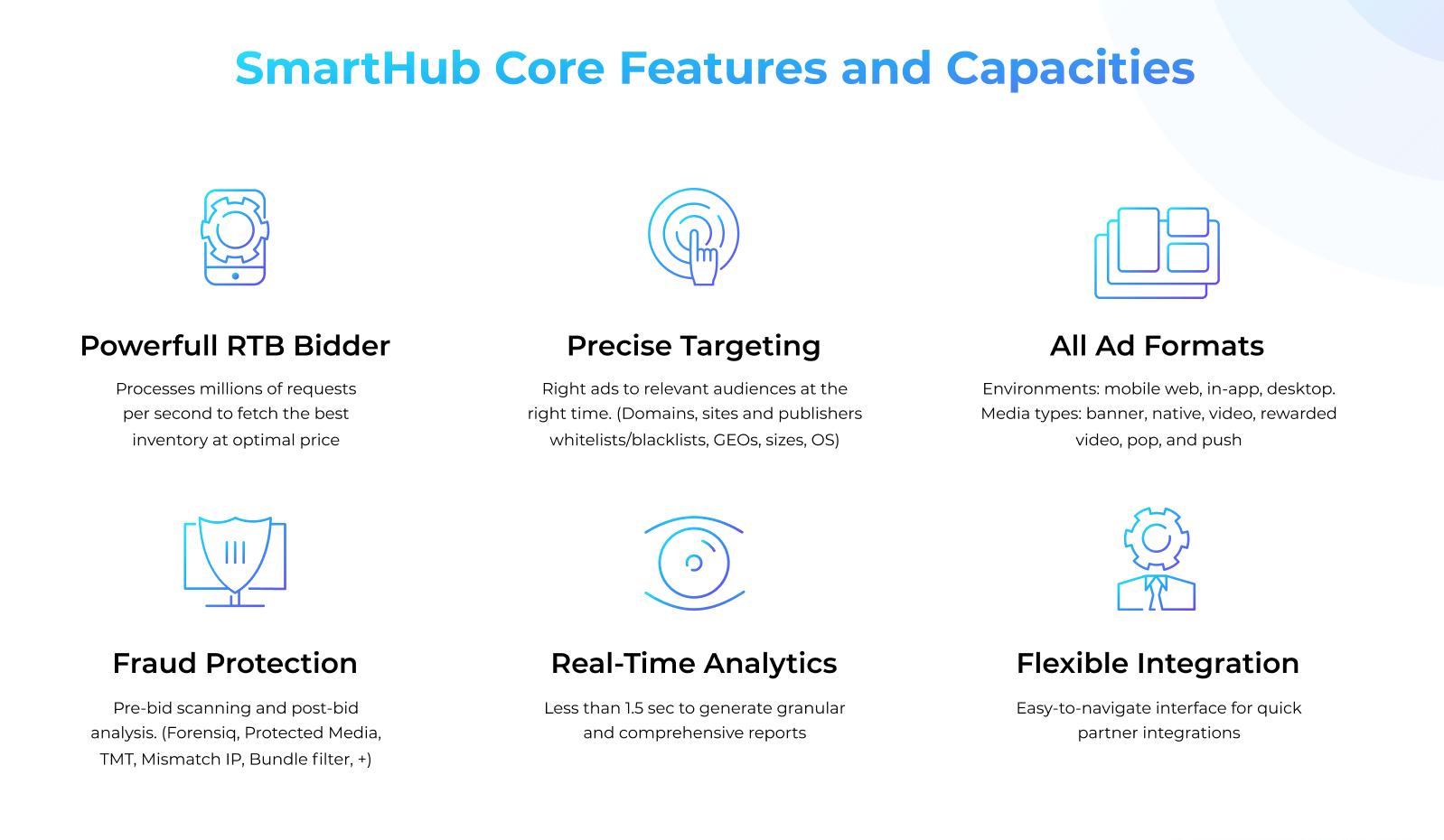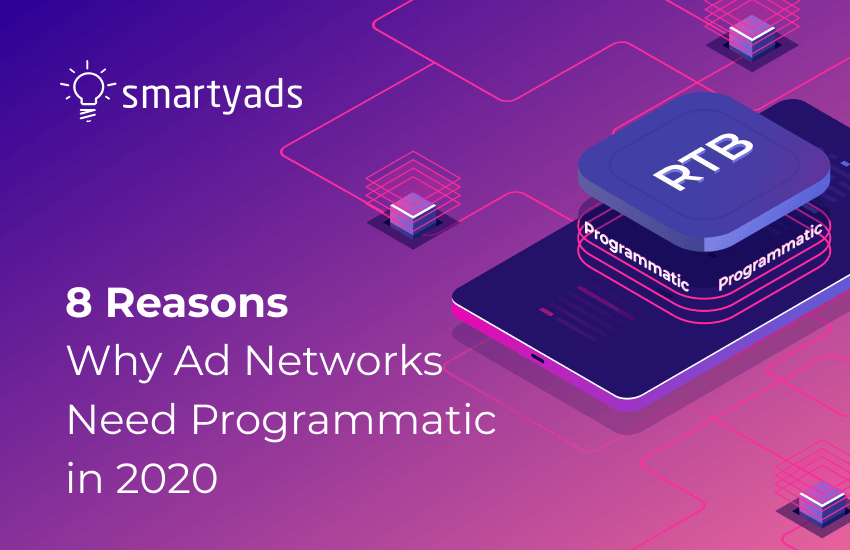What is programmatic advertising in 2020? Apparently it is a technology that is going to be in charge of ad spend generation that accounts for billions of dollars. If last year U.S marketers and advertisers spent over $60 billion on programmatic ads, by the end of next year (2021), they will fork over $81.00 billion (that will make 88% of all digital ad spend).
Where do these estimations stem from and why does the programmatic ecosystem today look so promising? Thanks to rising mobile gaming trends, shift to in-house and DTC marketing, 5G, digital ad formats, the future of digital advertising holds a great promise for everyone who taps into it this year.
With more personalization options, more channels, and finally a much easier transition to RTB advertising, ad networks can join programmatic advertising effortlessly, even if they have no big budgets or technology for it. For starters, let’s fetch the fresh market overview.
The programmatic market in 2020
Programmatic digital display ad spend has been growing exponentially, which we can see on the graph below with statistics delivered by eMarketer for 2016-2021.

If we go outside of the U.S we can see the same trend. Last year programmatic ad spend worldwide exceeded $100 billion for the first time. The next big rise is “planned” for 2021 then, the ad spend will reach $127 billion. As WFA study ranked countries by programmatic maturity, we can talk about the largest programmatic markets in the world. Here they are:
- Markets with the greatest programmatic spend are US, UK (together hold 64% of the total market) France and Australia.
- Rapidly growing markets: Germany, Brazil, Japan.
- Markets specializing in mobile: China, India, Indonesia.
- Markets that started to evolve: Malaysia, South Africa.
The main driver of programmatic development, as described in the report, will be emerging technologies like 5G, in-game and interactive ad formats, programmatic TV, etc. Since online user experience improves, it opens up new opportunities for omnichannel advertising, so the programmatic adoption will still actively grow at least in the next 5 years.

The reason for tremendous worldwide growth is simple - programmatic automates media-trading. For buyers and sellers, it is far easier to buy and sell media at one connected RTB marketplace than to collaborate with several partners separately. While for publishers and advertisers pros are pretty much straightforward, advertising networks that transition to RTB do not always realize what competitive advantages they obtain.
Benefits of programmatic for ad networks or Why Ad Networks should shift to programmatic
In a pre-programmatic era, ad exchange or ad network was playing the role of a link between advertisers and publishers. Now that processes are automated, believe it or not, the significance of ad networks even increases. Ad networks embrace real-time bidding technology and use it in order to create platforms that aggregate unique traffic across certain formats, mediums, or involve premium traffic partners. Combining technology with expertise, ad networks create the added value of service that can’t be achieved only with one component.
Automation and targeting
RTB technology enables purchasing ad inventory automatically via real-time bidding auctions and according to the targeting criteria configured in the dashboard. This allows advertisers to show advertising displays exclusively to the target audience of users on the right devices, at the right time, etc.
Targeting can take into account the interests, socio-demographic data, and behavioral factors in order to make the ad relevant to each user. If the ads are interesting to the users, they will convert easily, and the more conversions take place, the more profitable the network will be in the future.
Viewability of ads and fraud protection
Normally, the ad is considered to be seen if it appears on the website within one second, and if at least 50% of its pixels appear at the visible area of the page. But how to determine if the impression was shown to the user if you have no technology for it. How to recognize ads that were shown on the outside of the visible part of the window or those that accidentally overlapped each other? Programmatic has the most reliable tracking for this that advertisers can apply with pixels and tags. The number of impressions can also be measured in real-time.
Before analyzing the effectiveness of an advertisement, it is also necessary to find and filter out fraudulent bot profiles that may affect the results. Luckily, the majority of programmatic platforms today support anti-fraud mechanisms like ads.txt, app-ads.txt, sellers.json and supply chain that effectively eradicate fraud and prevent it from happening on all mediums.
Omnichannel reach and formats
The number of digital channels is constantly increasing: consumers use several gadgets before making a purchase. Therefore, to interact with customers throughout their user journey advertisers need to reach them everywhere: on the mobile, desktop, laptop. Even more so, there are new forms of digital channels that only programmatic can tap into like connected TV.
As the agenda of IAB annual leadership meeting 2020 illustrates: digital out of home, VR, AR, 5G, and technologies of a kind continue to emerge, there’s a high chance programmatic will be the first to embrace them. All popular ad formats are also adapting to the news screens and mediums and there’s no better way to pinpoint these new digital ad formats than plunging into the programmatic ecosystem.
Real-time optimization and global connection
There are various types of ad networks - horizontal, vertical, global, or local but programmatic functionality can be useful for each of those. The local-based ad networks that decided to expand their business and go international can make RTB integration and automatically connect to the global pool of partners. RTB protocol is a gateway to immense sources of inventory/direct advertisers as well as other exchanges, network partners also involved in RTB bidding.
Based on high-end technology, publishers can sell their inventory at the highest-valued CPM. Advertisers, meanwhile, can buy the most valuable impressions that correspond to the predetermined targeting and ad budget criteria.
How to integrate programmatic into ad network?
In order to survive in a highly competitive ad tech market, many ad networks develop their own technology for purchasing advertising inventory. Sure, when you create your own ad network from scratch it is a long and resource-consuming task. Still, such technology will enable you to customize processes, program interfaces, dashboards, and partnership network.
The greatest lifehack that helps to overcome challenges of building advertising platform from scratch is the white label business model. Purchasing a pre-made white-label solution the owner receives a finished, fully-hosted, and RTB connected technology that is ready to be customized and deployed in less than one month.
Such a network deployment concept is cost-effective and time-saving. There are plenty of reasons that can indicate why you need a white label ad tech platform, among which are:
- You need to easily integrate RTB into an existing network
- You need to start a network that functions according to your own payment terms/inventory quality
- You want to aggregate only certain type of traffic and re-sell it
- You have a plan for how to position your network as an exclusive market solution
- You strive to eliminate ad fraud or plan to create an exclusive network of partners
- You want to achieve extended traffic controls and optimization tools, etc.
White-label ad exchange from SmartyAds is a solution that helps enterprises to build RTB-powered, transparent, and customizable marketplace from the ground up. For the networks, it is also a chance to effortlessly transition to a highly-profitable programmatic ecosystem.
5 reasons to use SmartyAds WL ad exchange when you go programmatic
- Rich experience & available demand & supply. It’s always good when you ad exchange tech provider also has their own ad exchange - a guarantee that they know what they build. Every day, we work with advertisers, publishers, and entrepreneurs directly so we have enough knowledge to enhance and constantly improve our technology. Since 2011, we’ve built an entire tech infrastructure. This means you can always connect partners from our infrastructure right into your network to monetize more traffic.
- Customization. White label ad exchange can be customized from every point: dashboard, appearance logo. Integrate all partners that you like and enhance their traffic capacities. If you have non-standard partners, we can assist you with custom integration (on demand).
- Scalable technology. SmartHub is a SaaS cloud-based user-friendly technology unfolded on remote servers all over the world. All updates and improvements are happening in the background without affecting your network functioning. When your network expands, you can scale the platform automatically by switching to a larger QPS plan. We never cut or limit your traffic, so you can strike media trading on all environments and formats: video, banner, native, push, etc.)
- Shortest payback period. Technology is set up and ready to be used in less than a month. With a rapid market entry, you can occupy the right market niche and start earning sooner than your competitors.
- Extended marketplace functions: all formats, targeting, analytics, etc. SmartHub features extended controls for traffic monitoring and optimization as well as an abundance of ad formats, targeting options, metrics for analytics, and fraud-protection tools.
The following platform functionalities effectively boost ad network performance and guarantee the shortest network payback:

The last word
Programmatic, so far, is a single technology that is able to transform the capacities of the average inventory-aggregation networks and turn them into strong, data-driven, real-time advertising systems. If you don't want to fall behind, as a network owner, you need to embrace RTB-driven mechanisms or create platforms that have optimization, customization, scalability functions, and traffic navigation & monitoring controls that help to analyze and measure the performance of your marketplace. Luckily, a simple transition to these capacities today is possible with White Label tech platforms. SmartHub is a white-label technology that facilitates rapid market entry in case you’ve gathered supply partners or plan to connect the network to RTB. With SmartHub, you can build a unique and exclusive RTB-powered marketplace without investing time and money in development, testing, licensing, and maintenance.




